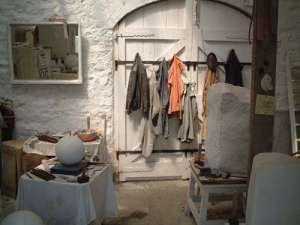

The Trewyn Studios, now the Barbara Hepworth Museum St Ives.
Left: The Stone Studio, Right: Plaster Studio
They have been left untouched since her death.
Adapting materials
After wining much international acclaim during the early 1950's demand for Hepworth's work was on the increase. Although she employed the use of assistants, who she trained to her own methods and high standards her studio couldn't keep up with demand.


The Trewyn Studios, now the Barbara Hepworth Museum St Ives.
Left: The Stone Studio, Right: Plaster Studio
They have been left untouched since her death.
Early on in her career she had adopted the "truth to material" principal. Where the sculptor works in unison with the material he/she is carving, by allowing the material to play a part in the formation of the form and the Sculptor to have a relationship with the material from start to finish. Using this principal, the sculpture should emerge as a shape of its own not just an enlargement of a mecket. This principal almost directly prohibited the use of bronze, as there was no relationship directly between the sculptor and the end bronze as craftsmen often enlarged and produced the final work. During the 1930's Hepworth was disconcerted to find that Jean Arp used crafts men to enlarge his meckets to make some of his final works.
In order for sculptors such as Hepworth to meet demand, and produce durable long-lasting sculptures they would have to compromise. Hepworth followed her contemporises, sculptors such as Reg Bulter, Henry Moore, and Paolozzi in developing their own ways of casting in bronze.
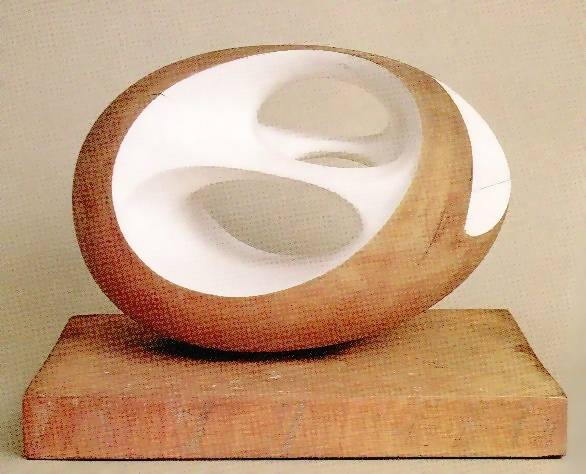
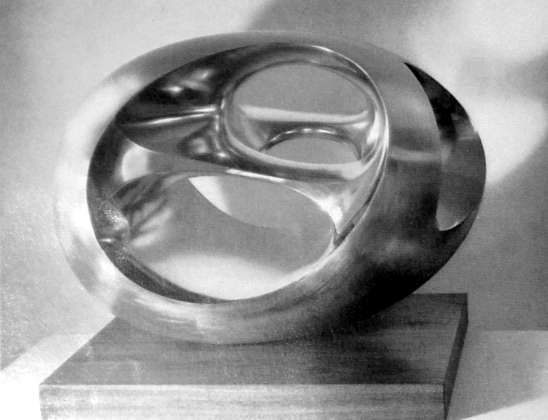
Oval Sculpture BH121 original in wood but Cast into bronze in 1959 to preserve the form, because of concerns over cracks in the wood.
Hepworth's development into bronze came for other reasons too, one was the need to produce more work and secondarily was the fact that many materials such as wood and stone spoiled over time developing cracks, stains and discolouring. Hepworth as did many of her contemporaries chose bronze because of its timelessness, hardwearing and durability - almost any shape or size of form can be cast in bronze. During the 1950's she asked for several earlier sculptures to be moulded and cast in plaster and bronze to save them from degrading because cracks had developed in them.
Although she had chosen to develop some sculpture for bronze casting she was adamant that no sculpture should be completed or cast in bronze after her death. Often many sculptures have been cast after a sculptor's death, in the example of Rodin many of his works in his own museum in Paris were realised in bronze after his death. In Canada there is a disputed collection of his works made up entirely of plasters which were formed from moulds. Hepworth was obviously concerned with preserving the integrity of her work and that it would not be lessened by numerous copies. Hepworth insisted that as she the sculptor, should have as much control over the finish and placing of the final pieces as possible.
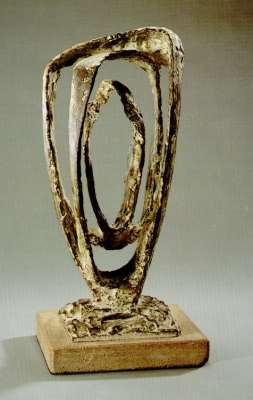
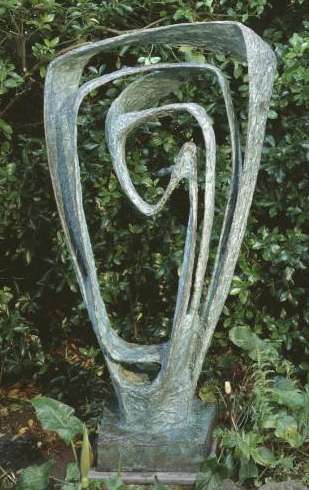
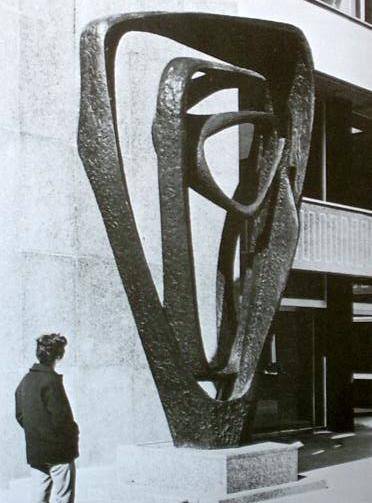
Three versions for Merdian showing differences in form between the mecket and final piece (Maquette Variation on a Theme 1958, Garden Sculpture (Model For Meridian) 1958, Meridian final 1960,
She also asked for some flexibility when pieces of her work were commissioned from patrons seeing small meckets, as she felt that the form should be allowed to alter as larger versions of it were constructed.
Hepworth chose a slightly different finish to her bronze works than that of her works in stone and wood. Mainly her works in stone and wood are wonderfully smooth with very specific surfaces. She used the surface of her sculptures to further communicate with the "spectator", in 1973 she said when talking about her bronze group "The Family of Man" :
" I think every sculpture must be touched, its part of the way you make it and it's really our first sensibility, it is the sense of feeling, it is first one we have when we're born. I think every person looking at a sculpture should use his own body. You can't look at a sculpture if you are going to stand stiff as a ram rod and stare at it, with as sculpture you must walk around it, bend toward it, touch it and walk away from it."

BH513: The Family of Man, 1970 BH513.
She constructed the basic shape of the form using a metal and plaster frame, and then applied what she described as Handwriting - texture to the form, this came in many forms such as layers of plaster applied with spatula type tools (Figure For Landscape 1959 BH287, Sea Form (Atlantic), 1964 BH362 (below), Rock Form (Porthcurno) 1964 BH363 ), caving back into the plaster (Family of Man 1973), polishing the bronze and applying patina to the cast bronze (such as in Vertical Form (st Ives) 1968/69 BH495, and the casting of River Form 1965 cast 1973 BH568 ). She uses the sense of touch, to rely the feelings the abstract forms represent. This is used as another tool of communication.
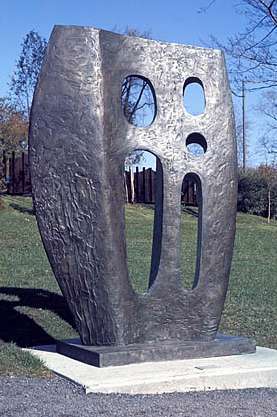
Sea Form (Atlantic), 1964 BH362
The bronze also allowed the use of scale in the work to effect and involve the viewer / spectator in the experience of a form. The use of scale as an extension of Hepworth's Sculptural language provided the means for a series of walk through instalations, such as Three obliques Walk in 1968 BH473, Four Square (walk through), 1966 BH433. In a radio interview in 1968 she commented:
"People don't always realise that there is no fixed point for a sculpture, there's no fixed point at which you can see It, there is no fixed point of light in which you can experience it because it is ever changing and it is a sensation which can never be replaced by words or colour or anything else at all."
The ultimate involvement that any of her sculptures invites you to is Four Square (Walk Through) 1966, the five piece bronze stands at over 4 metres high. The edition on display at her sculpture garden appears firstly like a massive gate, when you step inside, one experiences views over the garden and over St Ives though the Porthole type openings in the sides of the form.
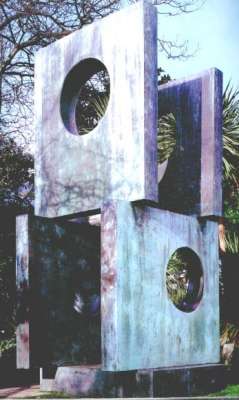
Four Square (walk through), 1966 BH433
The experience of the installation changes as you move though and around the piece. Despite its cold, hard, inorganic, severe, appearance when inside it feels warm and comfortable like a protective nest. This is one of the sculptures that I have personally experienced that conforms most to Hepworths later ideas.
As Hepworth's career developed she was invited to produce large scale commissions. These included Turning Forms, 1950 BH166 (Festival of Britian) , Single Form 1963 (United Nations New York), Winged Figure 1962 (John Lewis Oxford St), Theme and Variations 1970 pictured below (Cheltenham) . Hepworth believed that sculpture such as these commissions had a place in public spaces. Meridian for example was enthusiastically designed by Hepworth to contrast with the urban surroundings of the office block it is situated in front of.
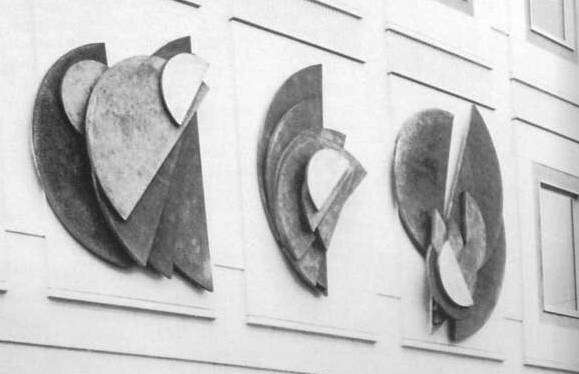
Theme and Variation 1970 BH511
In her prints of the later period involve both forms and colour (most produced within two suites of 12, Opposing Forms 1969, and the Agean Suite 1971). The colours she chooses are more reflective of mood than the natural colours from the landscape.
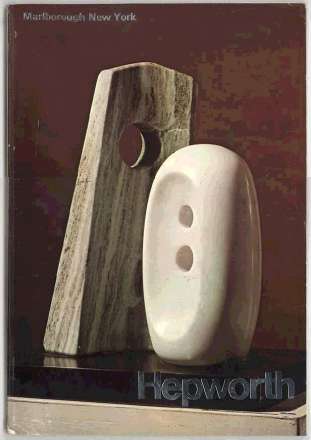
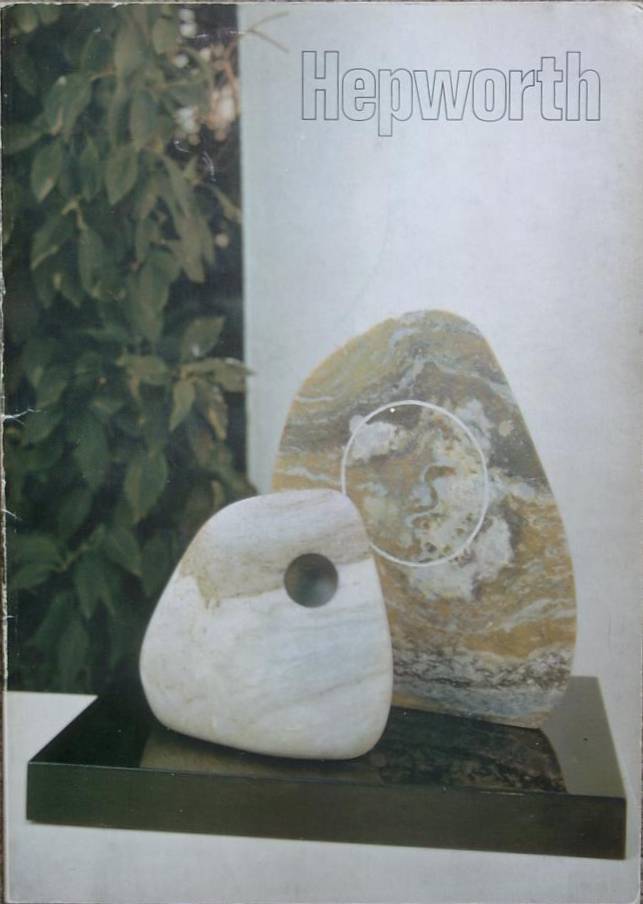
Left: Duo (Grey and white) 1973 BH563 - on the Cover of "Conversations Exhibition" Catalogue Marlborough NY 1974
Right: Two Opposing Forms Grey and Green 1969 BH492 on the cover of "Mayflower 70", Exhibition, Plymouth Museum, 1970
She also experimented with colour on her later sculpture, both different coloured stones (Two Forms (Apolima), 1969 BH493, Duo (Grey and white) 1973, Two Opposing Forms Grey and Green 1969) both pictured above) where the contrast of differing colours emphasise and adds weight to the forms, the deeper the colour the more there seems to be of that part. Colour properties of the material such as differnt metals (Disc with Strings (Sun), 1969, Disc with Strings (Moon), 1969 pictured below) , or layers in the stones carved (Rock Face 1973 BH560. Experiments with Accent colours (see Eos 1946 BH141, Two Figures 1968 BH460 ) show that brightness of colour and its place affect the adding depth and intensity to curve or hollow.

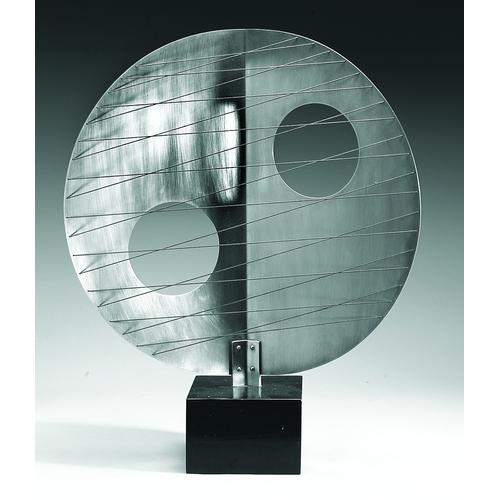
Disc with Strings (Sun) BH485, Disc with Strings (Moon) 1969, BH484
The interesting contrast between her early and later work is the evolution of the hole. In her pre war works the "hole" appeared as a way of connecting the surfaces of the form (Pierced Form 1931 BH35), during her post war work the "hole" opened the inside of the form giving it a weightless vastness (Corinthos 1954), the hole then evolved again becoming exact and calculated, forming into an exact Circle ( Single Form 1961 BH314). I think the hole in her post war sculpture represented the light, the source of the energy flow, the sun, the eye, the apex of belief.